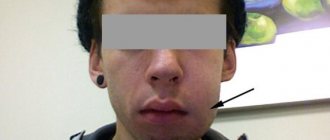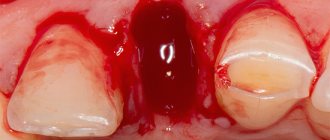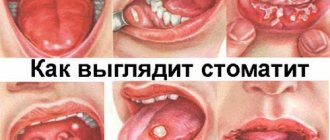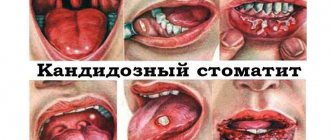There is hardly a person who has never had their teeth removed in their life. By middle age, usually everyone has to go through this unpleasant medical procedure - at least to remove incorrectly growing or initially diseased “eights” - wisdom teeth.
But when you decide to undergo such an operation for the first time, many questions arise:
- Is it normal to bleed for half an hour or an hour?
- What pain is considered normal, what is considered pathological, and when should it go away?
- Why did plaque appear after tooth extraction?
Healing of the hole after tooth extraction
The doctor usually warns about the duration of bleeding and the painful period, based on the characteristics of the operation performed: how complex it was, what kind of anesthesia was used, what the patient’s individual sensitivity threshold is. But the white plaque, which can be seen in the mirror a couple of days after tooth extraction, is scary: the dentist didn’t warn about it! Is it dangerous? Where did it come from and is it necessary to fight it? Let's discuss these issues so that there is as little reason for worry as possible.
Where does plaque come from?
Something white in the socket can be seen 2–4 days after the procedure was performed. It is a protein - fibrin. This protein compound is part of the blood coagulation system.
After the surgeon removes the diseased tooth, slight bleeding begins. This is normal, because they are torn:
- nerves;
- ligaments;
- small blood vessels.
All of them previously held the tooth in its designated place. Now a wound has formed, and the body is in a hurry to secrete stabilizing fibrin to stop the bleeding.
Attention! White gum covered with a fibrin film, or a white clot, is part of the fibrin that has protruded to the surface. The process is completely natural. The patient should not be concerned about the presence of plaque on the gums, since this is one of the stages of healing of the socket.
What pathologies can there be?
Removing a problematic tooth entails a violation of the integrity of the mucous membrane, rupture of blood vessels and nerves, especially if a wisdom tooth is pulled out. Ligaments, muscle fibers and soft tissues located in the operation area and holding the root are also injured.
As a result of surgical exposure, inflammatory processes begin to develop. This is an integral part of the recovery period, which is accompanied by the following symptoms:
- bleeding, the duration of which can reach 3 hours;
- pain syndrome spreading to the affected area and spreading to adjacent teeth, ears or nose;
- swelling of the wound and the area around it;
- redness of the gums at the site of tooth extraction;
- increase in body temperature to 38 degrees;
- burning in the operation area;
- impaired jaw function and discomfort when opening the mouth and eating food.
Gradually, all these symptoms become less intense and disappear. If the discomfort does not go away and intensifies, this may indicate the presence of a bacterial infection or the development of other pathologies.
The socket becomes inflamed
Sometimes tooth extraction surgery is complicated and takes a long time. Such an intervention causes more trauma to the gums and can negatively affect tissue regeneration.
The appearance of a white formation in the surgical area in some cases indicates the presence of inflammation in the oral cavity. The socket itself becomes inflamed with alveolitis. This disease is characterized by the presence of infections in the wound. The gray color of the plaque indicates that the disease is progressing. Under no circumstances should such a situation be left without attention and medical treatment. Advanced alveolitis turns into osteomyelitis and threatens with serious complications.
Some infections that get into the socket provoke the formation of pus, which is easily confused with fibrin deposits. It must be removed by a doctor using special solutions. Medications will help prevent further development of the disease.
The hole has a sharp edge
During the healing process of the hole, mucous membrane and bone are formed.
A prerequisite is the protection of the bone tissue from external influences from a blood clot or gum. When the wall of the socket is higher than the rest and has a sharp edge, it is able to break through the new mucous membrane and protrude into the oral cavity. The presence of an unprotected bone area increases the risk of developing alveolitis.
If quite a lot of time has passed after the tooth was pulled out, but the fibrous stain does not go away and something white is clearly visible on the gum, most likely this is the sharp edge of the wound. By touching it carefully, you can really feel its sharpness.
Read also: Tooth has decayed down to the gum
Small sharp edges gradually self-destruct. In more complex situations, minor surgery is performed. After anesthesia, the gum is moved back at the site where the sharp edge is formed and a piece of bone is removed, followed by suturing.
Removal was incomplete
It is not always possible to remove a tooth completely and notice it immediately. Dental residue with reduced immunity and neglect of hygiene will provoke alveolitis and thus reveal itself. In other cases, inspection will help to detect the forgotten root. After the formation of a white fibrinous film, it will become noticeable that the gums in this area are receding a little.
Why is raiding good?
When an alarmed patient comes to the surgeon who performed the operation for an unscheduled examination and asks to take a closer look at the wound after the removal of a wisdom tooth (or another), complaining of a milky soft (or hard) plaque, in most cases the doctor advises to simply wait without taking any action to remove it. Why?
The fact is that the formation of a fibrin film is evidence that healing has begun and the wound is healing. It plays the role of a blanket or bandage that reliably protects the wound from the penetration of microbes and mechanical damage.
The first day after the tooth is removed from its socket, a blood clot forms. The patient may feel that it is black or dark brown in color. Everything is correct: the blood coagulates and darkens. For the first 24 hours, the clot may be purple or burgundy. It fills the hole, slightly rising above it.
Then a fibrin plaque forms, and the clot gradually resolves. The mouth of the hole becomes smaller. Young, newly appeared cells of the forming bone, osteoblasts, move from the edges of the socket to the center. The body strives to fill the void, restore the integrity of the damaged membranes, and a thin white (perhaps gray or yellow - this is how the patient sees it in the mirror) film protects the cavity with an open wound from various infections, allowing immune cells to painstakingly do their work.
Don't be afraid of a light coating - this is normal.
Causes of white plaque
Many patients are concerned about the white spot that forms at the site of the extracted tooth after a couple of days. There is no need to worry about it, because this is an absolutely normal phenomenon.
The white film is fibrin, a protein formed from plasma. It appears due to necrosis of cells that “come out”, giving way to new epithelium. Human saliva contains a special substance that stabilizes fibrin.
Fibrinous white plaque performs an important function: it protects the socket from penetration of pathogens and mechanical injuries. Most often, a noticeable dense film appears on the wound after the removal of a wisdom tooth. Patients mistake it for accumulations of food debris or pus. Attempts to wash away the fibrin layer lead to interruption of the regenerative process. The wound may become infected.
Read also: After tooth extraction, medicine was put in the hole
An unpleasant odor accompanying wound healing can be considered normal. It appears due to the fact that it is difficult for a person, especially after wisdom tooth extraction, to open his mouth wide to perform hygiene procedures.
It is worth remembering that before the formation of a white fibrin film, you cannot use menthol rinses to destroy pathogens, otherwise the blood clot may fall out. You can see what plaque looks like on the site of an extracted tooth in the photo.
Plaque and unpleasant odor
Sometimes patients worry about the unpleasant odor emitted by the wound. Sometimes it is also a variant of the norm, because it is caused by the inability to carry out the usual hygiene procedures properly. So, for the first 8 hours after tooth extraction, your mouth may smell because you cannot use a brush and toothpaste.
Until the blood clot dissolves, you should not rinse your mouth: trying to clean all the cavities that are not yet allowed to be disinfected with a brush and paste, you can accidentally wash the clot out of the wound. Result: infection, need to take antibiotics, bleeding, slow healing.
In addition, after receiving permission from the dentist on Day 2 for the usual morning and evening brushing of teeth, gums and tongue, some patients find that they simply cannot do it. Reason: swelling and severe pain at the site of the extracted tooth. Sometimes the cavity, gums and cheek can hurt so much that it is even impossible to open your mouth completely, you have to drink juice through a straw and eat puree from a teaspoon. In such cases, it is physically difficult to brush your teeth.
Sometimes an unpleasant odor indicates the development of inflammation. Usually, pain is present at the same time (it increases on the 3rd–4th day instead of decreasing). Seeing a doctor is required at the first opportunity: it is possible that a purulent process has begun, especially if the plaque has acquired a green or yellow-green tint.
Main causes of inflammation
The occurrence of an inflammatory process after extraction is often explained by ignoring the doctor’s recommendations for care or unauthorized use of methods that are unacceptable in this clinical situation.
For the first two days, doctors do not recommend rinsing the mouth, as a blood clot may fall out and open the wound to various infections.
Therefore, doctors advise taking baths with sedatives or antiseptics instead of rinsing.
There are other causes of periodontal inflammation:
- during extraction, carious remains located in the root can penetrate into the wound. The infection that caused the removal continues to remain in the gum;
- food got into the hole after tooth extraction and the process of decay began;
- damage to blood vessels or nerves;
- if the resulting cavity is dry or there is no blood clot, then inflammation and suppuration may occur already on the second day after surgery. At first there is no strong pain. A slight aching pain occurs only during eating;
- during the procedure, the doctor may not notice the smallest bone fragments, which, remaining in the wound, will become an obstacle to the formation of a blood clot;
- complexity of the intervention, which is characterized by the problem of access (canines, molars or third molars), the presence of inflammation or the size of the root. When extracting an inflamed molar, the wound will heal more slowly and the chances of infection are much greater;
- Immediately after extraction, dentists advise changing your toothbrush, as a large number of bacteria settle on the bristles. Preference is given to a brush with soft bristles, which will not injure the periodontium during cleaning;
- due to reduced immunity or some chronic diseases (for example, blood or diabetes), the risks of developing inflammatory processes increase, since the wound will not heal for a long time and may fester in the future;
- food entering the wound cavity, which provokes pain. Therefore, you should not eat for the first three hours after removal.
Pain in the socket of varying intensity is observed for several days after tooth extraction.
Read also: Flux after tooth extraction This is considered a physiological norm and is explained by interference with the gum structure or tissue damage.
If the hole hurts after tooth extraction for 4-7 days, then do not panic.
You should follow all doctor's instructions and maintain oral hygiene. This will help make toothache less intense and last longer.
If pain continues to bother you a week after surgery, self-medication is not recommended.
The best solution would be to consult a dentist for a consultation and a more thorough examination.
Painkillers can be used for severe pain or as a temporary remedy.
Actions after tooth extraction
If the surgeon has removed a tooth, he will definitely give recommendations to the patient, the implementation of which will contribute to a speedy recovery.
Don’t worry that you will forget something: dentists understand perfectly well that after such a manipulation a person experiences pain and is nervous, and therefore they provide information on how to behave on a separately printed card.
Is it normal to have a fever after tooth extraction? Yes, perhaps it will even rise to 38 °C. You can knock it down at home with paracetamol. It will also have an analgesic and anti-inflammatory effect. A persistent or high temperature is a sign of the development of a purulent process. See a doctor immediately!
Recommendations are individual, but most likely you will hear that you cannot:
- for the first 2–3 hours, take any food or drink (the wound can become inflamed if foreign objects come into contact with its surface);
- smoking and drinking alcohol (when smoking, blood vessels spasm, bleeding stops prematurely, a blood clot does not form well, and alcohol can cause vasodilation and increased bleeding to dangerous proportions);
- warm the damaged area, visit the sauna, play sports (also leads to active blood flow);
- Rinse your mouth for the first 24 hours (to preserve the clot).
Apply ice or a bottle of cold water to the gum to relieve swelling, but do not hold it for long.
On the second or third day, the swelling may intensify and gumboil may appear. If a sharp throbbing pain occurs, consult a doctor as soon as possible.
Actions after wisdom tooth removal
Removal of front teeth usually goes without difficulty. The roots there are not so powerful, removing them is not accompanied by much pain, and everything heals quickly. Sixes and Sevens are more unpredictable. But the most difficult operation performed by dentists is the removal of a wisdom tooth. Causes:
- such teeth grow incorrectly, sometimes without crowns, erupting only by roots;
- the roots are confused, you have to cut them during the operation, which lengthens the procedure;
- there is a danger of not noticing pieces of tooth in a large bleeding wound and forgetting them there.
Wisdom tooth
It happens that removing a wisdom tooth takes more than one hour and requires additional anesthesia. If possible, take the next day off from work to recover. The steps are generally the same as after removing any tooth:
- do not eat or drink for 2–3 hours;
- do not touch the wound with your tongue;
- do not rinse your mouth;
- do not chew on the injured side;
- During the week, try to eat only warm, but not cold or hot food;
- take a pain reliever if the discomfort is very annoying;
- If the surgeon prescribed antibiotics, be sure to take a course.
Once the swelling and pain have subsided so that you can open your mouth normally, brush your teeth twice a day. Maintaining hygiene is a necessary condition for speedy healing.
Healing process
Extraction is performed with local anesthesia. Therefore, when its effect stops, the patient will feel an aching, throbbing pain. But it should go away the very next day, and over the next few weeks the healing process should be painless.
A blood clot forms at the surgical site, which prevents bacteria from entering the open wound and protects against inflammation.
To relieve unpleasant pain, experts recommend using an anti-inflammatory gel. With the gradual restoration of the mucosa, white appears in the socket after tooth extraction.
How to determine gum healing
During healing, a white film remains on the surface for several days. Swelling and pain may intensify on the 2nd day. By the third or fourth, you should feel relief. If you gently touch the damaged area with your tongue, it seems as if a lump has formed there.
There are 2 processes going on:
- bone formation (after all, part of it had to be pulled out along with the tooth);
- mucous membrane formation.
The plaque lasts for 5–7 days, after which it gradually disappears, the mucous membrane acquires a normal pink color. On the 10th day, nothing should bother you anymore. New epithelial tissue has formed, which closes the mouth of the socket.
But bone tissue regeneration has not yet been completed: this will happen in 3–6 months. The patient does not feel this process; it is visible only when examined by a dentist.
Alveolitis: how to detect and what to do
Sometimes tooth extraction is complicated by a disease called alveolitis.
His reasons:
- washing out of a blood clot as a result of the patient’s careless actions (the wound remains unprotected, infection is introduced there);
- the tooth was removed due to acute periodontitis or another disease;
- absence of bleeding during removal (if anesthesia with adrenaline was used);
- poor patient hygiene.
The patient himself may suspect something wrong.
By the 3rd–4th day he is worried about:
- increased pain;
- the appearance of throbbing pain;
- plaque with an admixture and smell of pus;
- temperature rise.
Alveolitis
You need to contact the surgeon who performed the operation. Potassium permanganate and hydrogen peroxide are used for treatment. When they combine, they form a foaming mixture that releases oxygen. Under the influence of this mixture, the purulent film is washed off and the source of inflammation is cleared.
Sharp edge of hole
One of the walls of the hole may rise above the others. If it has sharp edges, it cuts through the developing mucous membrane. Protruding outside, it remains unprotected. As a result, the development of an inflammatory process – alveolitis – cannot be ruled out. A dense white dot in itself does not hurt, but it causes concern. What to do? In most cases, it will disappear on its own. Sometimes a surgical procedure will be required to pull back the gums and apply a suture.
Under no circumstances try to do anything yourself! Only a doctor can cope with the situation.
Causes of white fibrinous plaque
In most cases, the resulting fibrin white layer in the socket does not pose a threat to health, but on the contrary is necessary for a speedy recovery. In some situations, white formations on the gums are signs of:
- the onset of the inflammatory process (alveolitis);
- sharp edges of the hole;
- presence of tooth remains.
In the presence of pathologies, the color and structure of plaque changes. Only an experienced doctor can notice these differences, so it is necessary to consult with a specialist who can accurately determine the nature of the white plaque.
When should you see a doctor?
Tooth extraction is a real mini-surgery. Theoretically, any complications that develop after surgery are possible, including problems with blood pressure and the cardiovascular system. Therefore, if something bothers you, do not hesitate to see a doctor again.
It’s better to let him conduct an examination and take the necessary measures in a timely manner than for you to wait for complications. In any case, you should see a doctor on the 3-4th day after removal so that he can tell you if everything is going well.
And even more so, you should visit the clinic if you have:
- the pain does not subside;
- bleeding does not go away;
- the pain has acquired a different character;
- temperature appeared;
- there are difficulties opening the mouth;
- there is an allergy to prescribed antibiotics (or they do not have an effect).
You will not be able to miss the appearance of painful sensations, as they are very bright. No, be patient: the sooner you take action, the faster the hole will heal, and you can install a prosthesis.
When are sutures removed after implantation?
In very rare cases, implant failure occurs, requiring surgical intervention. The following symptoms indicate this problem:
- acute pain;
- strong bad breath;
- mobility of the structure;
- redness and swelling of the mucous membrane near the implant plug.
We will look at the symptoms of complications in more detail below. Again, implant failure is extremely rare. According to statistics, new teeth do not take root in only 3-5% of cases. For example, German or Swiss implants will take root in 98% of procedures, and Russian or Israeli implants in 95%.
Therefore, if you detect even all of the listed symptoms, you should not set yourself up for negativity. Most likely, inflammation of the gums after installation of an implant is caused by more harmless reasons. Which ones? Let's deal with all the questions in order.
On average, implants take root in the lower jaw in 2-4 months, and in the upper jaw in 5-6. The bones of the lower jaw are generally larger, stronger and better supplied with blood, but above the upper jaw there is a maxillary sinus, which often brings additional difficulties when installing an implant.
In the language of science, the process of fusion of metal roots with bone is called osseointegration. Engraftment begins immediately after installation of the implant. The healing time of the gums and bones depends on the health of the patient, the condition of the jaw and the quality of the model itself.
The process of bone and implant fusion is influenced by many factors, of which the following can be distinguished:
- presence of allergies to implant components;
- deviation from doctor's recommendations;
- doctors' mistakes;
- bad habits (smoking);
- low quality implants.
According to statistics, inflammation of the gums near the implant and rejection of a foreign body are observed in most cases in the first days after the installation of new “roots”. The patient immediately feels that there are complications after the operation, and he needs to urgently consult a doctor.
However, even if inflammation of the gums near the implant does not occur, and the structure has taken root safely, the patient should be vigilant. In very rare cases, the implant may fail several months or several years after its installation.
Due to inevitable tissue trauma after implantation, the following symptoms are considered normal:
- swelling of the gums (in rare cases, the entire cheek swells);
- redness of the gums;
- discomfort and pain in the jaw at the site of the installed implant.
If the healing process goes well, after 3-7 days all unpleasant manifestations will go away. If the patient experiences pain, swelling increases day by day and healing does not occur, be sure to go to the dentist as soon as possible.
Signs of inflammation
Peri-implantitis, or inflammation of the tissue adjacent to the implant, can affect both soft and bone tissue. The gums become weaker, the bones are gradually destroyed, the implant begins to loosen and is rejected.
The first symptoms of peri-implantitis are similar to the usual consequences of surgery. However, the onset of rejection is more pronounced. Peri-implantitis is characterized by:
- acute pain that does not go away within 1-2 weeks after implantation;
- redness and swelling of the gums, which persist for more than 3-4 days;
- Blood flows from the wound for a long time (exudate). The ichor does not stop for more than 7 days;
- implant mobility;
- unpleasant odor under the plugs on the implants;
- discharge of pus from the gums, appearance of ulcers near the implants;
- increase in body temperature.
All of the above signs may be evidence of implant rejection and require urgent consultation with a dentist. If you notice at least one such alarming symptom, consult a doctor as soon as possible.
The most common cause of implant failure is medical errors:
- incorrectly selected size and design of the implant, due to which it cannot attach to the bone;
- non-sterile working instrument;
- overheating of tissues when drilling holes for the implant;
- incomplete information about the patient’s health status.
Often the cause of implant rejection and gum inflammation is the lack of sufficient bone tissue to secure it (bone atrophy). This problem can be solved with basal bone implantation, which ensures maximum fusion.
Another common reason for implant failure is the patient’s incorrect actions during the rehabilitation period. Even if the doctor performed the installation operation perfectly, in the following days it is important to treat yourself carefully and follow all the specialist’s recommendations.
During the engraftment period it is prohibited:
- load the implant;
- overheat/overcool;
- hide health problems and body characteristics from the doctor;
Even if it seems to you that your health problems are insignificant, and the characteristics of your body have nothing to do with the implantation procedure, tell your doctor about all possible ailments. Often, what seems frivolous to you can fundamentally affect the treatment method.
If the implants do not fail in the first two years after installation, we can assume that the operation was successful. However, the problem of rejection can overtake the patient several years after the operation. As a rule, such a situation occurs against the background of exacerbation of chronic diseases or mechanical injuries. Diabetes, tuberculosis, AIDS and cardiovascular diseases can lead to implant failure.
If, after 2,3 or even 5 years of a quiet life with an implant, you notice that the gums under the crown or next to it have begun to swell, bleed, and you have begun to suffer from bad breath, immediately contact your dentist. The doctor will conduct a comprehensive examination of the oral cavity, order an x-ray and, if necessary, open the wound to clean out the pus.
Unfortunately, even after a few years, if there are signs of re-implantitis, and therefore a serious threat to the life and health of the patient, the doctor will order removal of the implant.
In most cases, 2-3 months after removal of the implant, a new structure can be installed. After removal of the previous implant, no more than 1-2 months should pass, otherwise the bone tissue may atrophy due to the significant load.
It is useful to keep in mind that some complications may arise directly during the dental implantation procedure, right on the dental chair. Moreover, the nature of the undesirable consequences may depend on whether the implant is installed on the upper or lower jaw.
Below is a short list of possible complications that may occur during the implantation procedure (in descending order of frequency):
- Heavy bleeding;
- Pain;
- Perforation of the bottom of the maxillary sinus and nasal cavity;
- Damage to the wall of the mandibular canal and nerves of the lower jaw.
Let's look at these complications in order.
Heavy bleeding
During dental implantation, minor bleeding is considered normal and in most cases can be easily controlled with conventional hemostatic techniques. Heavy bleeding can occur both due to the fault of the doctor and the fault of the patient himself.
It is within the power of every person who sits in a dental chair to reduce the risk of developing this complication. Most often, bleeding from a wound occurs with increased blood pressure, as well as with a blood clotting disorder (taking blood thinners, cardiovascular pathology, etc.).
Blood pressure control, timely intake of medications under the supervision of a cardiologist or therapist, proper medication and psychotherapeutic sedative (relieving nervous tension) preparation, as well as mandatory informing the implant dentist about existing diseases will help avoid not only early bleeding during implantation, but also in the delayed period.
Sometimes, during the dental implantation procedure, quite severe painful sensations may occur, which, however, can usually be easily eliminated with an additional dose of anesthesia.
But in rare cases, it happens that anesthesia does not work well. This is most often due to the individual characteristics of a person. This situation is resolved simply: dental implantation is carried out under anesthesia, in other words, when consciousness is turned off.
DETAILS: Braces and face. Bite after braces and teeth after removing the braces system
Therefore, if you have been injected with an anesthetic, but you still feel pain, you do not need to endure and remain silent - you should definitely and immediately tell the doctor about it.
Currently, this complication of implantation is much less common than it used to be. Advances have been made largely due to the ability to accurately determine the distance to cavities using panoramic images and computed tomography (CT).
In order to reduce the risk of this complication to almost zero, you need to trust only an experienced doctor with extensive experience, and in case of doubt, consult with other implantologists. If the maxillary sinus is close to the bottom of the nasal cavity, bone augmentation (sinus lift) can be done first, and then no problems arise.
Prevention: advice from Dr. Zubastik
Of course, ideally, it is better not to let the situation get to the point where you need to remove a tooth, that is, maintain hygiene and see a dentist at least once a year.
But the situation is not always completely under the patient’s control. Sometimes you need to pull out:
- wisdom tooth interfering with neighboring teeth;
- a tooth on which a crown was incorrectly installed;
- a tooth that creates an obstacle to the formation of a correct bite.
The patient’s main task is to follow all the surgeon’s recommendations after surgery. Do not rinse your mouth for the first day after the procedure, do not smoke. During the first week, be especially attentive to your health: do not get too cold, avoid places with large crowds of people, so as not to catch any virus.
Try to maintain hygiene requirements as much as possible. If brushing your teeth is still difficult, on the 3-4th day, simply rinse your mouth with a solution of water and toothpaste (from now on you don’t have to worry about the clot being washed out).
Forget for a while about active sports and your favorite sauna. In 10 days you will be able to freely train in the gym and take a steam bath, but for now, be patient.
Be sure to take a course of antibiotics if the surgeon considers it necessary to prescribe them. This is done after the removal of complex teeth, for example, “eights”, or if the tooth was eliminated due to inflammation.
And most importantly: stay calm. Tooth extraction is an unpleasant procedure, but nothing in this world lasts forever: your discomfort will pass. A little patience - and everything will be fine!
Tags: Alveolitis, White plaque, Tooth extraction
About the author: Dr. Zubastik
Typically, a toothache begins to subside on the way to the clinic and finally goes away after 10 minutes of sitting in line to see the dentist.
- Related Posts
- Nausea again... How to overcome the gag reflex when brushing your teeth?
- Preventing dental caries: 5 simple tips
- What to do with white plaque on teeth?
« Previous entry
Indications and contraindications for dental implantation and their relationship with possible complications
It happens that a fairly quick process of tooth extraction does not go as desired. Complex cases are when the duration of the removal itself lasts longer than usual, and the doctor has to perform more manipulations. The procedure itself is complex, which means that the recovery process may be burdened with some difficulties. Usually the doctor warns you how long the painful sensations will last, how to relieve them, and what to pay attention to.
Removing so-called wisdom teeth is a particularly difficult process; the wound has to be sutured. Sutures on the gum oblige you to be even more attentive to the wound and strictly adhere to the doctor’s recommendations.
Rules of conduct after wisdom tooth extraction:
- Do not open your mouth too wide - there is a risk of seams coming apart;
- if the doctor prescribed antibiotics, take them strictly according to the schedule;
- the temperature has increased - take an antipyretic;
- for acute pain, you need to take painkillers; the pain can last a week or a little more.
If the pain is severe and lasts more than 10 days, rush to see a doctor. The risk of complications cannot be excluded, and this will require special therapy and dental procedures.
Absolute contraindications to dental implantation:
- Chronic diseases in the decompensated stage;
- Serious disturbances of hemostasis;
- HIV and a number of other seropositive infections;
- Some mental illnesses.
Relative contraindications:
- Diseases in the acute stage, especially acute viral infections;
- Chronic infectious diseases;
- Condition after heart attack and stroke;
- Pregnancy and breastfeeding;
- Risk of bacteremia in patients with prosthetic heart valves who have had rheumatism or endocarditis;
- Exacerbation of chronic forms of diseases;
- Treatment with medications that impair tissue regeneration.
Relative contraindications give the doctor the right to delay the dental implantation procedure. For example: after a complete cure of a viral disease, a year after a heart attack, after finishing breastfeeding a child, stopping taking medications that create risks of complications during and after implantation, etc., All this is necessary to minimize the risks of developing negative consequences during dental implantation.
If necessary, bone grafting can be performed and drug therapy can be prescribed to suppress infection at the site of inflammation. After restoration of damaged tissue, re-implantation is performed.
So here are these tips:
- you should realize in advance that responsibility for the result of treatment lies not only on the shoulders of the doctor, but also on you (an undisciplined patient who does not follow the doctor’s instructions can ruin the results of even the most exquisite work);
- choose a clinic with a “name” - as a rule, large centers invest in modern equipment and staff training;
- choose a professional doctor with experience and positive recommendations and reviews (the choice of a doctor is a more important point than the choice of a clinic);
- give preference to high-quality implants - not lower than the average price segment (you should choose well-known brands that have been on the market for at least 5-7 years);
- comply with all doctor’s requirements after surgery and monitor oral hygiene;
- and, of course, do not forget to regularly undergo preventive examinations of the oral cavity, promptly treat diseases of the teeth and gums and care for them daily.
In general, the risk of becoming one of the patients whose implants are rejected is minimal. It is much more likely that they will serve you faithfully for many decades, or even a lifetime.











